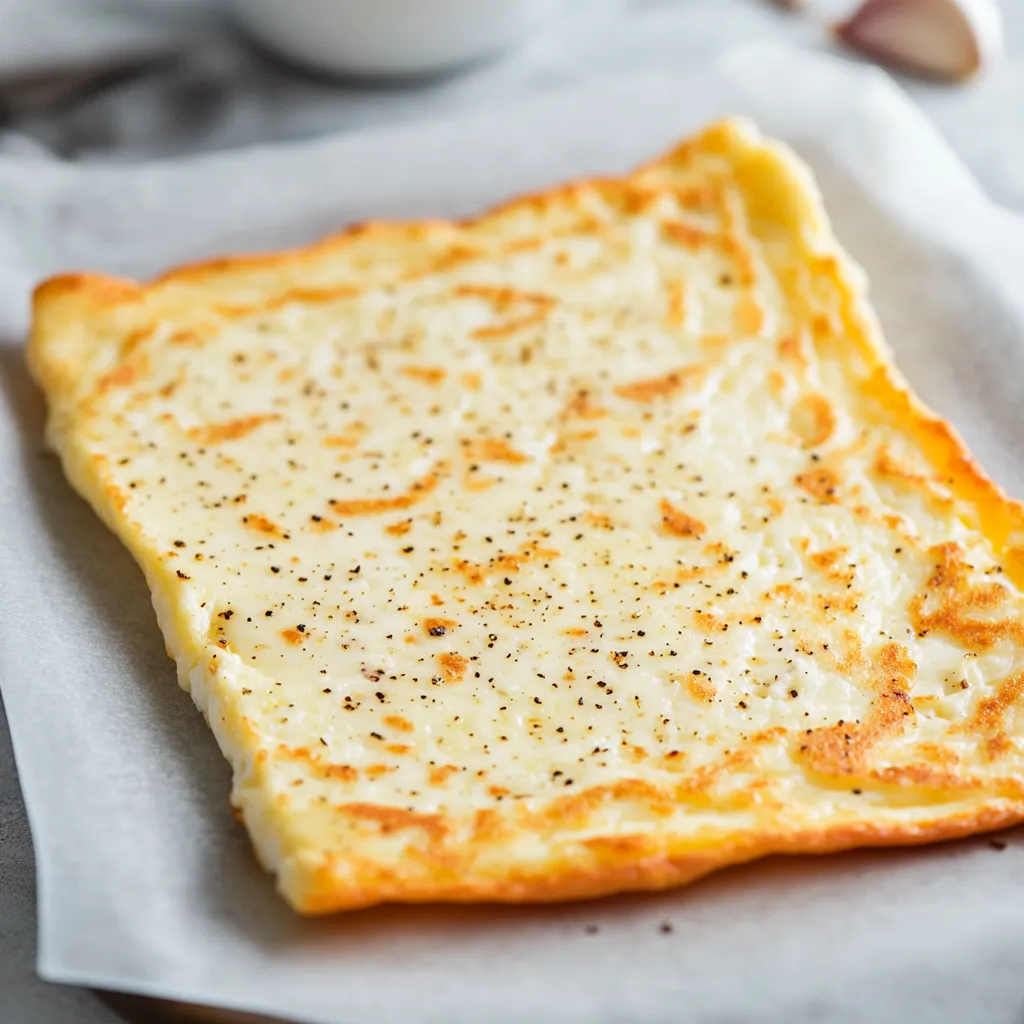 Pin it
Pin it
Keto Cottage Cheese Parmesan Flatbread transforms simple pantry staples into a versatile bread alternative that satisfies carb cravings while supporting low-carbohydrate dietary goals without compromising on texture or flavor satisfaction. This remarkable flatbread features a tender interior with slightly crisp edges that maintain enough flexibility to fold without breaking, making it perfect for wraps and pizza bases alike. The combination of creamy cottage cheese and savory parmesan creates a protein-rich foundation with subtle cheese notes that complement rather than overpower whatever toppings or fillings you choose to add. Unlike many keto bread alternatives that can taste eggy or have unusual textures, this flatbread achieves a neutral canvas that convincingly mimics traditional flour-based breads while delivering significant protein content that helps sustain energy levels throughout your day without the carbohydrate spike and crash cycle.
I discovered this recipe during my third month of keto eating when bread cravings threatened to derail my progress entirely. After experimenting with multiple almond flour alternatives that never quite satisfied, this simple flatbread became my kitchen salvation. My husband, who typically avoids my "diet food," actually requested this flatbread for his own sandwiches after trying it, confirming that it transcends the typical limitations of specialized dietary recipes to become simply good food that happens to be keto-friendly.
Simple Ingredients
- Full-Fat Cottage Cheese: Creates the moist, tender structure that distinguishes this flatbread from drier alternatives. Choose small-curd varieties for the smoothest texture when blended.
- Large Eggs: Provide binding properties and protein while helping the flatbread achieve a bread-like texture.
- Parmesan Cheese: Contributes savory depth and helps create the slightly crisp exterior. Freshly grated varieties melt more consistently than pre-packaged options.
- Garlic Powder: Adds aromatic depth that enhances the savory profile without overwhelming.
- Black Pepper: Provides subtle heat and complexity that balances the dairy richness.
- Sea Salt: Enhances all other flavors while controlling the perceived sweetness of the dairy components.
Preparation Method
- Prepare The Baking Surface
- Preheat the oven to 350°F. Line an 8x8-inch baking pan with parchment paper and lightly coat it with oil.
- Create The Batter
- Blend cottage cheese, eggs, parmesan, garlic powder, black pepper, and sea salt until smooth.
- Form The Flatbread
- Pour the batter into the prepared pan, spreading evenly to ensure uniform thickness.
- Bake To Perfection
- Bake for 25-30 minutes until the edges turn golden and the center is set.
- Cool Strategically
- Let cool in the pan for 10 minutes, then transfer to a wire rack to cool completely.
- Remove From Parchment
- Carefully peel the parchment from the flatbread to prevent tearing.
- Cut To Size
- Slice according to your intended use: halves for wraps, quarters for pizza bases, or strips for dipping.
- Store Properly
- Refrigerate in an airtight container for up to three days or freeze for longer storage.
 Pin it
Pin it
Serving Inspirations
Use as a wrap for Mediterranean-style fillings, a base for keto pizzas, or a breakfast option with eggs and avocado.
Flavor Variations
Incorporate fresh herbs, experiment with different cheeses, or add everything bagel seasoning for a customized flavor experience.
Storage Strategies
Refrigerate flatbread between parchment layers for up to three days, or freeze for up to a month. Reheat gently in a skillet.
 Pin it
Pin it
This keto flatbread bridges the gap between dietary needs and culinary satisfaction, offering a versatile solution for low-carb meal planning.
Frequently Asked Questions
- → Can I use low-fat cottage cheese instead of full-fat?
- Yes, you can use low-fat cottage cheese, but the texture and flavor of the flatbread may be slightly different. Full-fat cottage cheese produces a richer, more pliable flatbread that holds together better. If using low-fat, you might want to add an extra teaspoon of olive oil or melted butter to compensate for the lower fat content.
- → How do I prevent the flatbread from sticking to the parchment paper?
- Make sure to spray the parchment paper with cooking spray before pouring in the batter. After baking, let the flatbread cool for 3-5 minutes before attempting to remove it. Use a thin spatula to gently separate the edges first, then slowly peel back the parchment paper from one corner while supporting the flatbread with your other hand.
- → Can I add different seasonings to change the flavor?
- Absolutely! This flatbread is extremely customizable. Try Italian seasonings like basil and oregano for a pizza base, taco seasoning for Mexican-inspired wraps, or everything bagel seasoning for a breakfast option. You can also add dried herbs, onion powder, or even a pinch of cayenne for heat. Just add these with the other ingredients before blending.
- → Can I make multiple flatbreads at once and store them?
- Yes, you can easily double or triple this recipe and bake multiple flatbreads. Once cooled completely, separate them with pieces of parchment paper and store in an airtight container in the refrigerator for up to 3 days. You can also freeze them for up to a month. To reheat, warm them gently in a dry skillet over medium-low heat or microwave for 15-20 seconds.
- → Why is my flatbread too soft or not setting properly?
- This could be happening for a few reasons. Your oven temperature might be too low, so consider using an oven thermometer to check accuracy. The flatbread might need a few more minutes of baking time - it should have lightly browned edges and be set in the center. Also, make sure you're blending the mixture thoroughly to fully incorporate the egg, which helps with structure.
- → Is this flatbread suitable for diabetics?
- Many diabetics find this flatbread works well with their meal plans due to its low carbohydrate content (only 4g net carbs) and high protein (20g), which helps prevent blood sugar spikes. However, everyone's body responds differently to foods, so it's best to monitor your own blood glucose response. As always, consult with your healthcare provider about specific dietary recommendations.
